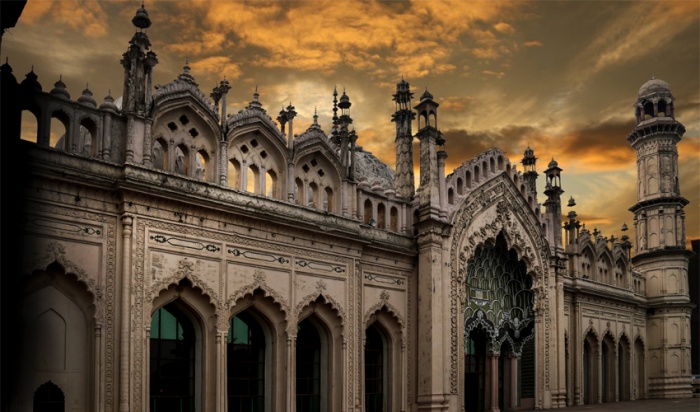Jama Masjid
(Detailed Write-up)

Jama Masjid is the most famous mosque of Lucknow. It was built by Mohammad Ali Shah in 1840 in the east of Husainabad. Foundation of this magnificent mosque was laid on a high mound at Tehsingani contemporaneous with than of the former building. The mosque of Miyan Almas and Imambara Nawabganj on the Kakori Road were already in existence at that time.
On his ascendance to the throne, the Badshah had already reached an advanced age. He was suffering from arthritis and could not even eat food with his own hands. He had two wives by name of Malka Aafak Saheba and Malka Jahan Saheba. Nawab Malka Aafak belonged to the family of Moghul rulers of Delhi and was known as Khas Mahal. Nawab Malka Jahan, on the other hand, hailed from a poor family. Though she was a “Syedani’, Badshah preferred to eat food with her help. Malka Aafak’s residence was at the Mahalsara at Husnabagh. Thus Malka Jahan Saheba had greater opportunity to serve her husband. Besides, being issueless she could devote much more attention to her husband than Malka Aafak. She had served him faithfully during the latter part of his life.
On 16th May 1842, the Badshah breathed his last. He was unable to complete the construction of the Jama Masjid and Satkhanda Palace in his life-time. On account of a prevailing superstition, a building left incomplete by a nawab was not brought to completion by his successors. Jama Masjid being a place of worship was, however, considered an exception and Malka Jahan considered it her duty to arrange for its completion. Keeping the ambitions of her late husband in view, she did not hesitate to spend her wealth open heartedly to make this building one of the most magnificent structures.
‘Lakhori bricks’ and lime : Amongst the historical buildings of Avadh built with ‘Lakhori bricks’ and lime, Jama Masjid is unique in its combination of its expanse and structural embellishment. Some historians have even labeled it as the best architectural, heritage of the period. The mosque is a unique example of Aasfi school building. The main attractions are three lotus-shape ‘Kamrakhi’ domes and proportionate minarets. The umbrella rooftops of these minarets show stone arches built with stones in Gothic architecture. The ‘clove-flowers’ intervening the ‘Kangooras’ too are made of stones. The main arch of the mosque and the stucco-work on it is very attractive. The interior of the mosque too has beautiful designs. The favourite mosque of Malka Jahan had since time immemorial been a venue for the ‘Badi Namaz of Juma’. As such, it came to be known as the Jama Masjid. Malka Jahan could not complete the construction of the adjoining Imambara on account of her departure from Lucknow. Near Jama Masjid also existed the Pili Kothi- the residence of royal hakim. This building was provided with green coloured columns. On 25th September 1857 when General Outram arrived with his forces to regain control of Hussainabad and Tehsinganj, he had made a brief halt at this very Pili Kothi (The Yellow Bungalow). Then it was provided with two cannon, strategically positioned to guard the area around the building. On the night of 25th September itself, this building was target of an attack by the revolutionaries. Ruins of this building now lie beside the road.
In 1901 the Lt. Governor Sir Anthony Macdonald had sanctioned rupees twelve thousand for renovation of Jama Masjid. This old mosque has thus survived the ravages of time, and stands today as a proud heritage of ancient Lucknow.
Source : Monuments of Lucknow, Yogesh Praveen


